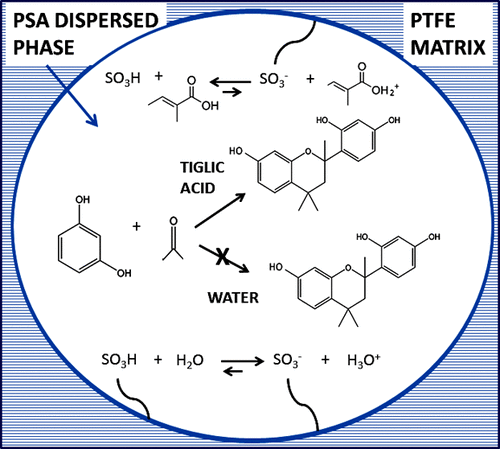当前位置:
X-MOL 学术
›
Anal. Chem.
›
论文详情
Our official English website, www.x-mol.net, welcomes your
feedback! (Note: you will need to create a separate account there.)
Water-Resistant Polymeric Acid Membrane Catalyst for Acetone Detection in the Exhaled Breath of Diabetics
Analytical Chemistry ( IF 6.7 ) Pub Date : 2018-01-17 00:00:00 , DOI: 10.1021/acs.analchem.7b03808 Adam D. Worrall 1 , Zexin Qian 1 , Jonathan A. Bernstein 2 , Anastasios P. Angelopoulos 1
Analytical Chemistry ( IF 6.7 ) Pub Date : 2018-01-17 00:00:00 , DOI: 10.1021/acs.analchem.7b03808 Adam D. Worrall 1 , Zexin Qian 1 , Jonathan A. Bernstein 2 , Anastasios P. Angelopoulos 1
Affiliation

|
Endogenous volatile organic compounds (VOCs) such as acetone in exhaled human breath are associated with metabolic conditions in the bloodstream. Development of compact, rapid detectors of exhaled breath chemical composition in clinical settings is challenging due to the small sample size that can be collected during a single exhalation as well as spectroscopic interference by the abundance of water. In this paper, we show that the activity of a catalytic polymer membrane (Nafion 117) toward the heterogeneous condensation reaction of immobilized resorcinol reagent with gas-phase acetone can be preserved even at 100% ambient relative humidity through the incorporation of organic acids such as vanillic or tiglic. The reaction produces a colored flavan product that permits highly selective and sensitive correlation to acetone concentration in exhaled breath. Such behavior suggests solvent displacement, analogous to homogeneous liquid-phase systems. However, unlike classic acid–base equilibria, the extent of optode water resistance is shown to increase with the pKa of the imbibed organic acid while peak signal intensity of the imbibed acid undergoes a bathochromic shift to longer wavelengths. These observations are consistent with competition between organic acid deprotonation by water in a mixed solvent system on the one hand and immobilization on the other. Finally, we demonstrate how when applied to the direct chemical analysis of acetone in exhaled human breath, the approach yields excellent correlation to blood glucose in diabetics.
中文翻译:

用于糖尿病患者呼气中丙酮检测的耐水聚合酸膜催化剂
呼气中的内源性挥发性有机化合物(VOC)(例如丙酮)与血液中的代谢状况有关。由于在单次呼气过程中可以采集的样本量小,并且由于水的存在而产生光谱干扰,因此在临床环境中开发紧凑,快速的呼气化学成分检测器具有挑战性。在本文中,我们表明,即使在100%的环境相对湿度下,通过引入有机酸(例如,Nafion 117),催化聚合物膜(Nafion 117)对固定的间苯二酚试剂与气相丙酮的多相缩合反应的活性也可以保留。香草的或蒂格里奇的。该反应产生有色的黄烷产物,其允许与呼出气中的丙酮浓度高度选择性和敏感相关。这种行为表明溶剂置换,类似于均相液相系统。但是,与经典的酸碱平衡不同,光阻耐水程度显示出随着p的增加而增加。吸收的有机酸的K a,而吸收的酸的峰值信号强度经历红移到更长的波长。这些观察结果与一方面在混合溶剂系统中水使有机酸去质子化,另一方面与固定化之间的竞争相符。最后,我们证明了当应用于呼出的丙酮中丙酮的直接化学分析时,该方法如何与糖尿病患者的血糖产生极好的相关性。
更新日期:2018-01-17
中文翻译:

用于糖尿病患者呼气中丙酮检测的耐水聚合酸膜催化剂
呼气中的内源性挥发性有机化合物(VOC)(例如丙酮)与血液中的代谢状况有关。由于在单次呼气过程中可以采集的样本量小,并且由于水的存在而产生光谱干扰,因此在临床环境中开发紧凑,快速的呼气化学成分检测器具有挑战性。在本文中,我们表明,即使在100%的环境相对湿度下,通过引入有机酸(例如,Nafion 117),催化聚合物膜(Nafion 117)对固定的间苯二酚试剂与气相丙酮的多相缩合反应的活性也可以保留。香草的或蒂格里奇的。该反应产生有色的黄烷产物,其允许与呼出气中的丙酮浓度高度选择性和敏感相关。这种行为表明溶剂置换,类似于均相液相系统。但是,与经典的酸碱平衡不同,光阻耐水程度显示出随着p的增加而增加。吸收的有机酸的K a,而吸收的酸的峰值信号强度经历红移到更长的波长。这些观察结果与一方面在混合溶剂系统中水使有机酸去质子化,另一方面与固定化之间的竞争相符。最后,我们证明了当应用于呼出的丙酮中丙酮的直接化学分析时,该方法如何与糖尿病患者的血糖产生极好的相关性。











































 京公网安备 11010802027423号
京公网安备 11010802027423号